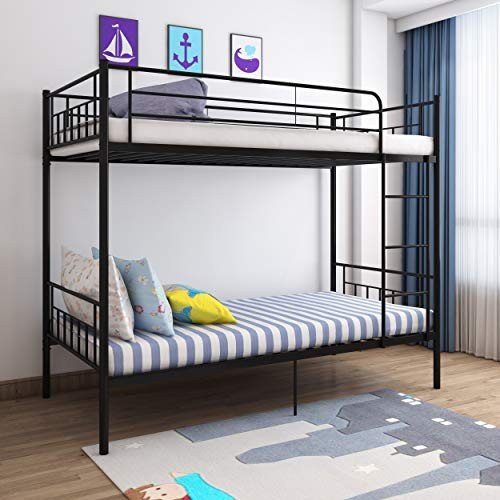10 Fundamentals About Bunk Beds You Didn't Learn In School
Exploring Bunk Beds: A Comprehensive Guide
Bunk beds have actually long been a staple in children's bed rooms, dorm rooms, and even homes with minimal space. Not only do they supply a useful sleeping solution, however they likewise produce an enjoyable and creative environment for kids and a great space-saver for adults and households. This article will check out whatever you require to know about bunk beds, from types and materials to safety suggestions and buying suggestions.
Tabulation
- Kinds Of Bunk Beds
- Traditional Bunk Beds
- Loft Beds
- Triple Bunk Beds
- L-Shaped Bunk Beds
- Material Options
- Wood
- Metal
- Safety Considerations
- Purchasing Guide
- Frequently asked questions
Types of Bunk Beds
Bunk beds come in different styles to fit different needs and choices. Here's a breakdown of the most common types:
Conventional Bunk Beds
Standard bunks usually feature 2 beds stacked vertically on top of one another. These beds are ideal for siblings sharing a room or for maximizing sleeping space in guest rooms.
Loft Beds
Loft beds stand similarly to traditional bunk beds however do not have a lower sleeping location. Rather, they frequently integrate a desk or seating location beneath, making them a great choice for small rooms needing multifunctionality.
Triple Bunk Beds
Triple bunk beds are created for three residents, with beds stacked in a three-tier configuration. These are less typical however can be an enjoyable solution for big families or pajama parties.
L-Shaped Bunk Beds
With one bed positioned horizontally and the other vertically, L-shaped bunk beds are frequently geared up with extra functions such as desks or storage drawers and can complement corner spaces in a space.
Contrast of Bunk Bed Types
Bed Type
Perfect Use
Description
Traditional
Shared bed rooms or visitor rooms
Two beds stacked vertically
Loft
Small spaces needing multi-purpose space
Upper bed with open space below
Triple
Large families or pajama parties
Three beds stacked vertically
L-Shaped
Corner or flexible spaces
A combination of vertical and horizontal beds
Product Options
Bunk beds are produced from various products, with wood and metal being the most typical. Each product has its pros and cons.
Wood
- Toughness: Generally robust and can endure years of use.
- Aesthetic Appeal: Offers a traditional appearance that can mix with different designs.
- Weight Capacity: Typically stronger; can support much heavier weights.
- Drawbacks: May be more costly than metal options and can be vulnerable to scratches.
Metal
- Strength: Generally light-weight and simple to move but still durable.
- Modern Design: Often comes in streamlined styles, making it appealing for modern areas.
- Affordable: Usually more economical than wood options.
- Downsides: Can be cold to the touch in winters and might not have the very same visual appeal for some purchasers.
Security Considerations
When it concerns bunk beds, safety can not be overlooked. Here are crucial security tips to keep in mind:
- Guardrails: Ensure that the top bunk has guardrails on both sides to prevent falls.
- Tough Construction: Check for a solid build and durable products to withstand weight and movement.
- Weight Limit: Adhere to the manufacturer's weight limitation for both the upper and lower bunks.
- Ladder Design: Choose bunks with a safe, easy-to-climb ladder and avoid any sharp edges or rungs.
- Age Restrictions: Most manufacturers recommend that children under the age of six need to not sleep in the upper bunk.
Buying Guide
When looking for bunk beds, think about the list below factors to discover the best fit for your needs:
- Space Availability: Measure the space size and ceiling height, making sure there is adequate space for the leading bunk.
- Bed Size: Decide between twin, full, or bigger sizes based upon your needs and the size of the room.
- Style Preference: Consider the overall decoration of the bedroom to discover a suitable design.
- Relieve of Setup: Look for a bunk bed that is simple to put together.
- Budget: Bunk beds come in numerous price ranges, so identify a spending plan before starting your search.
Frequently asked questions
1. What is the suggested age for children to sleep on the leading bunk?
Kids aged 6 and older are typically suggested to sleep on the leading bunk to decrease the risk of falls.
2. How can I make my bunk bed more secure?
To improve security, make sure guardrails are properly set up and check that the bed is put on a flat surface area. Furthermore, motivate kids to utilize the ladder thoroughly.
3. Can bunkbedsstore.top transform a bunk bed into two separate beds?
Lots of bunk beds are developed to be convertible. Inspect the producer's requirements for convertibility features.
4. What devices are available for bunk beds?
Typical devices consist of bed linens, storage drawers, staircases instead of ladders, and tented canopies for a fun visual appeal.
5. How do I keep my bunk bed?
Regular checks for loose screws or structural integrity can assist guarantee safety. Dust the bed frequently and clean spills quickly to keep the products in good condition.
Bunk beds are flexible and a space-efficient service for numerous living circumstances, from children's spaces to guest accommodations. With numerous designs and materials readily available, prospective purchasers have a wealth of options to think about, ensuring a mix of practicality and visual appeals. By focusing on security and following the suggestions outlined in this guide, people can discover the right bunk bed that fits their space and lifestyle, all while producing a satisfying sleeping environment.
